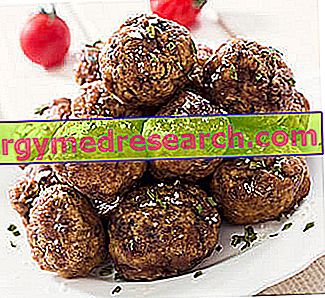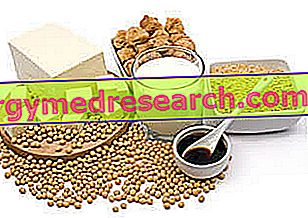Generality
Meatballs are a rustic and homemade food, which falls into the category of dishes.

Meatballs are born as a recycling system for cooked or raw foods. The passage to the meat grinder of trimmings and small pieces of meat remaining from other recipes is in fact a fairly widespread method for "not throwing away anything"; alternatively, it is possible to carry out a knife beating (now replaced by the mixer) of cooked leftovers, such as escalopes, roasts, grilled meat, etc. Everything is then amalgamated by the egg, structured by the breadcrumbs, flavored with cheese and flavored with the various spices, thus obtaining the meatballs ready to be cooked.
From the point of view of sanitation, meatballs are not always considered a safe food; being often used to "dispose" of meat in the process of deterioration, they should be excluded from the diet of subjects potentially at risk of complications. Below we will better understand why.
Meatballs for all tastes
Traditional Italian meatballs
Meatballs are traditionally composed of ingredients of both animal and vegetable origin. The classic Italian recipe (if there is one ...), involves the use of: minced meat, eggs, breadcrumbs, cheese, aromatic herbs, salt, pepper and vegetable oil for frying. NB . The ingredients have not been specified in the proper quantities regarding the great heterogeneity of the territorial formulas.
This promiscuity totally excludes them from the vegan philosophy and the ovo vegetarian act. There are also many other religious differences, for which the meatballs should be eliminated from the Muslim diet (if they contain pork), Hindus (if they contain bovine), kosher (if they contain pork, for mixing meat and cheese, if the meats come from animals that have not been slaughtered according to the Sechita ritual, etc.).
Referring again to traditional Italian meatballs, it is a food that does not lend itself to the diet against overweight, to the diet against hypercholesterolemia, to the diet against disorders of the gastro-intestinal tract, to the diet against the tendency to biliary lithiasis and to clinical nutrition in general. They contain gluten, lactose, milk proteins, egg proteins (whole) and sometimes seed oils; they are therefore impertinent to the diet against celiac disease, to the diet against lactose intolerance and to the exclusion diet against the allergens contained in the aforementioned foods.
OPTIONS
Compared to the traditional recipe, there are dozens of meatballs (perhaps over a hundred) of variations. There are ground meatballs, chopped with a knife or mixed with the food processor; breaded and fried meatballs, baked in the oven, stewed in the sauce, sautéed or boiled vacuum-packed at low temperature; meat balls without bread, without eggs, without yolk or without cheese; fish-based meatballs, based on offal, based on legumes, based on cereals (or other seeds), based on fruits and / or vegetables or based on food for vegans. Each ingredient can be added or eliminated, always keeping in mind that the dough should remain compact and tasty.
These foods are very similar to meatballs: meatloaf, hamburgers (or burgers), raw Piedmontese meat, tartare (meat or fish), various croquettes, etc.
Hygienic sanitary aspects
As anticipated, meatballs are not always considered a safe food from the point of view of hygienic health and, in certain places of collective catering, it would sometimes be wiser to exclude them from the food of potentially at risk subjects; these include: pregnant women, weaning children or in any case small, very old subjects, compromised or immunodeficient subjects, etc.
Let it be clear, a food prepared at home, from fresh and controlled food, if properly cooked, can be eaten by virtually anyone. The same, however, cannot be said of the meatballs offered in certain restaurants or fast-food restaurants.
The risks associated with the consumption of meatballs are mainly linked to three factors: parasitic contamination of meat or fish, bacterial contamination of any ingredient and the presence of bone chips. We proceed with order.
- Parasitic contamination of meat : may be due to a premortem or postmortem condition of the animal used for meat, depending on the type of parasite; some are: toxoplasma, tapeworm, trichinella, horseshoe, pinworms and anisakis (the latter only for fish tissues). It is true that meatballs should always be cooked and that there is no parasite that can withstand heat treatment above 70 ° C or much below 0 (-20 ° C). Bearing in mind that the most moderate cooking technique is the "low-temperature vacuum boiling", which uses 60, 65 or at most 70 ° C (for a very long period), the risk should be practically reduced "to the bone ". With the other cooking systems, temperatures rise dramatically, ensuring a certain guarantee of disinfestation. On the other hand, it is not uncommon for frying or stir-frying to overdo the temperatures and risk scorching the meatballs. These (already tougher than cooking over whole meat), if large in size and spherical in shape, will hardly reach the "heart of the food" a desirable temperature for meat disinfestation.
- Bacterial contamination of meatballs : bacteria are a real scourge for meatballs, as well as for other ground foods. Those most responsible for human diseases are: Clostridium perfringens, Staphylococcus aureus, Salmonella etc., which can contaminate the ingredients before or after grinding, compromising their conservation. Let us not forget that food maintenance is strictly influenced by their contact surface and the consequent adhesion of microorganisms to the substrate; since the meatballs are made from chopped or ground ingredients, their potential for contamination is much higher than a "whole" product. Unlike parasites, bacteria are able to replicate quickly, produce spores (some very resistant to the aforementioned temperatures) and produce endo- or exo-toxins. All this translates into the fact that frozen foods, even when brought to -20 ° C, cannot be considered sterile. The preservation of the meatballs (raw or cooked) is therefore more limited than the single whole ingredients. "Low-temperature vacuum boiling" does not guarantee meatball hygiene. Higher and more accurate cooking can eliminate the bacteria and the related exotoxins (which are proteic in nature), but they are less likely to destroy their spores, which can flower once the temperature is reduced (for example, in refrigerated storage). No type of cooking can eliminate the endotoxins of their cell membrane, as they are lipidic in nature, therefore thermostable; ergo, dead bacteria that are a source of endotoxins can still cause food poisoning.
- Presence of bone splinters : it is a problem linked above all to the feeding of children and dysphagia to solids, which often like this kind of food because it is soft and easily chewable. On the other hand, since it is a food probably composed of scraps of excess meat, it is not uncommon to contain fragments of bone or cartilage. Mostly they are very small pieces that do not affect the health of those who ingest them; more rarely, they can scratch the esophagus, impair swallowing and / or stimulate the urge to vomit.
Nutritional Features
Defining the nutritional properties of meatballs is certainly not a simple task. As specified in the chapter "Meatballs for All Tastes", the variations of this food are as many as the ingredients available to the human being.
It is however possible to define that, in Italy, the most consumed types of meatballs are: fried meatballs, meatballs stewed in sauce, fish balls and soy meatballs.
Below, you can find a nutritional summary table of these recipes:
| Beef Meatballs fried | Beef Meatballs stew al Sugo of Pomodoro | Meatballs of Salmon and Cod baked | Meatballs of Soy (Miso, Okara) | ||
| Edible part | 100% | 100% | 100% | 100% | |
| water | 51, 5g | 76, 6g | 67, 1g | 64, 1g | |
| Protein | 17, 0g | 8, 9g | 12, 7g | 4, 3G | |
| Prevailing amino acids | - | - | - | - | |
| Limiting amino acid | - | - | - | - | |
| Lipids TOT | 19, 2g | 5, 8g | 4, 1g | 3, 1g | |
| Saturated fatty acids | 4, 3G | 1, 9g | 0.8g | 0.5g | |
| Monounsaturated fatty acids | 7, 2g | 2, 9g | 2.0g | 1.4G | |
| Polyunsaturated fatty acids | 6, 4g * | 0.5g | 0.8g | 0, 9g | |
| Cholesterol | 75, 7mg | 47, 5mg | 24, 0mg | 0, 0mg | |
| TOT Carbohydrates | 10, 9g | 7, 3g | 15, 0g | 28, 3g | |
| Starch | 9, 8g | 2, 6g | 12.5 g | 27.6 grams | |
| Soluble sugars | 1, 1g | 4, 7g | 2.5g | 0.7g | |
| Ethyl alcohol | 0.0g | 0.0g | 0.0g | 0.0g | |
| Dietary fiber | 0.7g | 1.0g | 1.4G | 1.5g | |
| Soluble fiber | - | - | - | - | |
| Insoluble fiber | - | - | - | - | |
| Power | 288, 4kcal | 114, 9kcal | 148, 0kcal | 151, 4kcal | |
| Sodium | 245, 0mg | 370, 7mg | 156, 2mg | 205, 1mg | |
| Potassium | 226, 9mg | 273, 1mg | 332, 8mg | 372, 3mg | |
| Iron | 1, 8mg | 1.2mg | 1.0 mg | 1.2mg | |
| Football | 118, 5mg | 76, 8mg | 53, 9mg | 46, 9mg | |
| Phosphorus | 204, 1mg | 118, 0mg | 14, 5mg | 68, 5mg | |
| Thiamine | 0, 19mg | 0.05 mg | 0, 23mg | 0, 08mg | |
| Riboflavin | 0, 20mg | 0, 12mg | 0, 16mg | 0, 03mg | |
| Niacin | 4, 16mg | 2, 00mg | 3, 90mg | 1, 67mg | |
| Vitamin A (RAE) | 33, 51μg | 28, 85μg | 167, 10μg | 1, 78μg | |
| C vitamin | 1, 4mg | 4, 58mg | 5, 70mg | 7.5mg | |
| Vitamin E | 3, 73mg | 1, 42mg | 0, 84mg | 0, 67mg | |
As can be seen from the summary table, the preparation with more calories is undoubtedly that of fried meatballs. It boasts a higher lipid and protein content, while carbohydrates are higher in soy vegan meatballs.
Cholesterol is higher in fried meatballs, while fibers are more in vegan than soy.
From the vitamin and saline point of view there is not much to add, except that the derivatives of animal origin contain a greater quantity of molecules of group B.
Taking meatballs into consideration, it is necessary to specify that these foods are not suitable for nutritional therapy. Fried meatballs do not lend themselves to the treatment of overweight subjects due to the very high caloric intake. In addition, people with hypercholesterolemia should also be avoided, regarding considerably more significant cholesterol and saturated fatty acid content.
Video Recipe Light meatballs without eggs
NB . * The proportion of polyunsaturated fatty acids (benefits) of fried meatballs is rather high because, in the recipe, the use of a frying oil based on various seeds is recommended. In reality, it is not the best product for this kind of preparation and, even if the value of polyunsaturated fats seems to be quite significant, they are however damaged by heat, losing all metabolic properties.
Even people with gastro-intestinal and / or digestive disorders should limit the consumption of fried meatballs. These are not easy foods to digest, which is why they are not recommended in the case of: gastritis, gastro esophageal reflux, peptic ulcer, tendency to biliary lithiasis and irritable colon.
Most types of meatballs contain gluten (except for gluten-free ones), which is why they should be avoided by celiacs. Likewise, due to the presence of cheese (except for vegan ones), lactose intolerant should eliminate or drastically limit their consumption ..



